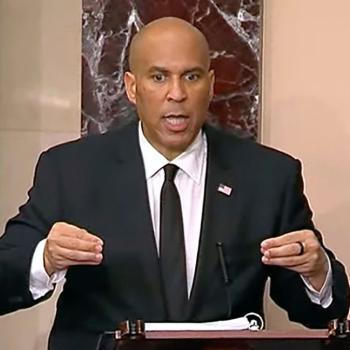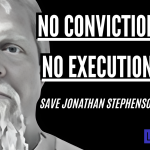For Sunday, May 13, my first Sunday in the UK, I had intended to go to Trinity Church Sutton, but discovered that they were combining services with Sutton Baptist Church, and the Anglican St. Nicholas Church. The three churches, all located almost next to each other, have combined services monthly in the evenings, and yearly during the main service time (10:30) on Christian Aid Sunday. Sunday, May 13, Mother’s Day in the US, was Christian Aid Sunday in the UK.
Curious, I prevailed upon my daughter-in-law to get me to that combined service. She knows the area well as it is near the school my grandchildren attend. It’s about two miles from their house–in time, I hope to be able to walk that far without even thinking about it, but am nowhere near able to do that right now.
Parking in the UK is an ongoing nightmare, but she knew of a parking garage a couple of blocks away. I walked up a steep hill and crossed two busy streets to get to the building.
I arrived at the Baptist Church, the host church, four minutes early. Three different people welcomed me, one at the door, another with a bulletin and a third at the back of the sanctuary. I asked that one if there was any special place I should sit and she said “no,” so found a spot near the back in a nearly full pew. The sanctuary seats 220 at maximum capacity. By 10 minutes into worship, we were at maximum with the three churches together.
About ten “juniors” (eleven and under) were dismissed to Junior Church shortly into the service. With perhaps four older teens and a few parents, the rest of the congregation were a lovely ethnic mix with the vast majority over 65.
A complete bulletin contained everything needed for worship, all prayers, words to hymns, responses, etc. Scripture references were in the bulletin, but not the Scriptures themselves. When the readers prepared to read, they did announce the page in the pew Bibles, but there were no Bibles available.
The service began with a greeting from the Baptist pastor (I missed his name and it was not in the bulletin), and an explanation of the day. He particularly noted how the offering for Christian Aid day would work, and that church members who put their offering in their own church envelopes would find such funds sent to their own church treasuries.
The hymns were familiar but the tunes were not, with no hymnals for guidance. However, a nice organ and some great congregational singing (no choir) helped.
We focused on Sierra Leone. We heard a great summary of that mineral-rich but poverty-stricken nation. One of the Scripture readers was herself from Sierra Leone and it was with great pleasure that I listened to the reading of God’s holy word from her accented English.
The pastor brought an excellent fourteen minute message on the question: “Does belief in God make it easier or harder to resolve human suffering?” With the acknowledgment that such belief makes it harder, he explained that we are to serve in partnership with a good God who identifies with the poor and suffering and to take seriously our responsibility as people of comfort to do whatever we can to relieve that suffering in the name of Jesus.
A series of prayers and responses followed and then the Lord’s Prayer, printed in the bulletin in Krio, the language of Sierra Leone. We were all encouraged to pray that prayer in our own native tongues. “Simply splendid” as the British say.
The offering was taken during the final hymn and we were dismissed. Then . . . well here is the major problem with a combined service. Each person thinks that all unknown persons are from one of the other churches. Not one person spoke with me or even met my eye. I wandered around a while, trying to look lost and lonely (not hard at that point) and no one offered a hand or help.
I looked for the pastor, but he had quickly abandoned his post at the exit area.
Coffee, tea, juice and cookies (biscuits here!) were being served and I’ve no doubt that I could have partaken, but I honestly wanted to see if an invitation would be forthcoming without me making the initial move. Nope.
I looked for the restroom and noted that it was unisex with a glass front door. Glad I could wait.
I left, unnoticed and unnamed.
Other Critiques:
The Anglican Church website contains almost no information at all. Would guess that this is very much a dying parish. Trinity Church is actually a part of a denomination formed by connecting the United Reformed, http://www.urc.org.uk/ and British Methodist http://www.methodist.org.uk/ denominations together. I haven’t figured this out yet, as they are also many Methodist Churches that are not part of the merger, I think. Hope to find out more in a few weeks.
The Baptist preacher sounded just like a US United Methodist in his affirmation of present day kingdom of heaven work. I did not hear any of the types of messages more likely to be coming from a Southern Baptist Church, such as emphasis on individual salvation and the blood of Jesus. Not at all what I expected. There was no communion service this Sunday so I don’t know how that might have worked with the three churches. It is clear they have worked together for some time and publish a joint parish magazine several times a year. Would have liked to see a copy but didn’t find a place to pick up any literature.
Much insider language used. With the way people were introduced and the assumption of much common knowledge, it appears that they are not in the habit of having guests or visitors. This is something all churches need to watch especially during announcement time: not everyone knows what is going on, and there needs to be a way to get information out that doesn’t leave the outsiders even more on the outside.
Speaking of announcement time: It seemed to me that nearly ten minutes were given over to it–very much distracted from worship. But there really wasn’t much worship. It was more an informative time. We learned about Sierra Leone and learned how we might help, and I appreciate that. But I saw no movement toward the transcendence of God, or acknowledgement of the Holy Presence.
The person who does the first read on my newspaper articles and offers important critiques asked this:
Does the lack of personal attention and responsiveness to you cause a deflation in your experience there or does the service itself carry the day? For some people like me, it is the whole package deal that matters with the sermon standing out as the culmination of my experience.
This is an important question and deserves reflection. How much does it matter to make some sort of personal connection within a worship environment? I suspect much depends upon the assumptions we bring with ourselves when we go into worship. A number of years ago, I attended Mass at the Cathedral of Notre Dame in Paris, France. I had no expectation of being greeted or making connection with anyone there–I just wanted to experience the Mass in that place. I also had no expectation of going back or being united with a worshipping community where we would be doing the work of growing to maturity in Christ in connection with one another. And that is the crux of this: living as a Christian is not a “long ranger” experience–to some degree, it must be done in community where we can sharpen one another–and learn to forgive one another.
I’m essentially a deep introvert, and have had to teach myself how to walk with confidence into a place where I know no one. It doesn’t come naturally. Those with wonderfully extroverted personalities have never met strangers, and can make friends within seconds no matter where they are. It is different for those on the other end of that personality spectrum. A welcoming hand means a lot. And that just didn’t happen here, although I seriously doubt it was by intent. It’s just that no one thought about it–no one considered what would happen to the stranger who decided to show up that day.
All churches need to periodically re-evaluate the welcome and insider/outsider messages offered to strangers and help close the cracks that we are often simply overlook.
















